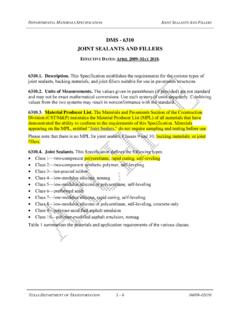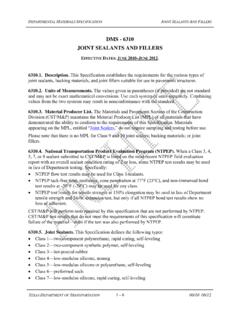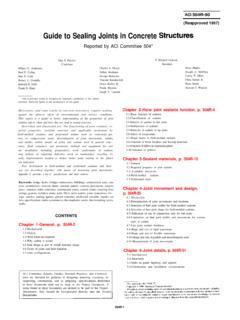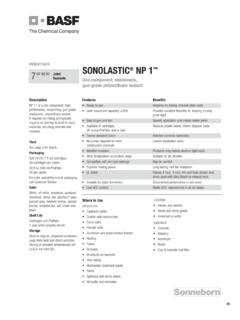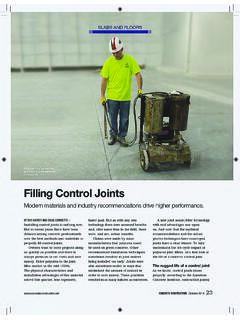Transcription of Polyurea Sealants for Control Joint Applications
1 Polyurea Sealants for Control Joint Applications Robert M. Loomis Willamette Valley Company 660 McKinley Street Eugene, Oregon 97402 Charles O. Idowu ChemRex Inc. 889 Valley Park Drive Shakopee, MN 55379 ABSTRACT Polyurea sealant technology can find its origin in slower reacting spray Polyurea systems developed at Texaco Chemical Company in the late 1980 s [1]. In this paper, we have presented a new type of Control Joint filler developed from the latest Polyurea sealant technology, and investigated its compression-deflection characteristics, movement capabilities, and physical properties. During this investigation, two commercially available epoxy Control Joint fillers were subjected to the same compression-deflection test, and it was discovered that the Polyurea Control Joint filler provided equal compressive resistance.
2 The Polyurea Control Joint filler was specially formulated to provide a balance between stiffness (compressive resistance) and flexibility. The flexibility of the Polyurea Control Joint filler allowed the product to complete ten cycles of movement without experiencing loss of adhesion or cohesive failure. In addition, we observed how the unique cure characteristics of this Polyurea Control Joint filler was fast and consistent over a wide range of temperatures. INTRODUCTION In recent years, Polyurea sealant technology has played an important role in meeting the increasing need for a faster curing sealant in the construction industry. Polyurea Sealants fit within the category of field-molded, thermosetting, chemically cured Sealants as defined by American Concrete Institute Committee 504 [2]. Field-molded Sealants are used in nearly every concrete structure and perform a variety of functions based on structural design, service conditions, and economic constraints.
3 One area in concrete construction where Sealants perform a very important function is in the area of Control joints. Control joints are cut into concrete slabs to permit shrinkage-induced movement or contraction, and Control anticipated cracks while the concrete cures. The Control Joint width is typically inches wide by inches deep and the spacing of each Control Joint can be as wide as 20 feet. These intentionally placed joints, or gaps, in the concrete slab will widen as the concrete cures. The function of a properly formulated Control Joint filler is to create a polymeric bridge between two Joint edges, and protect these concrete edges as a load crosses over the Joint . Without proper support and protection by the Control Joint filler, the Joint edges will soon begin to deteriorate and lead to increased facility maintenance costs. In this paper, we focus on Polyurea Sealants as Control Joint fillers , and how their performance properties meet the requirements of a Control Joint .
4 In order to properly engineer a Polyurea sealant for Control Joint Applications , one must understand the fundamental performance hurdles of Control Joint fillers . Basically, Control Joint fillers are faced with two performance hurdles maintaining adequate adhesion under normal service conditions and movement, and resisting compression under a load. A consequence of the Control Joint fillers failing to adhere, or separation from the Joint edge, is the introduction of a gap between the Joint filler and the concrete slab. This gap leaves room for foreign solid matter to become trapped, and generate undue stress on the Joint leading to deterioration of the concrete Joint . Furthermore, separation of the Joint filler from the Joint edge leaves an area where the Joint edge is unprotected, and a load must be transferred over this area without the aid of the filler.
5 Failing to meet the second performance hurdle, resisting compression under a load, will expose the concrete Joint edge to wheel impact damage during load transfer. In light of these performance hurdles and their consequences, it appears Control Joint fillers must overcome these hurdles with opposing performance properties flexibility and stiffness. Optimizing these two performance parameters has been the challenge faced by Control Joint fillers based on epoxy and polyurethane technology. Presented in this paper is a specially formulated Polyurea Control Joint filler that has met this challenge by maintaining its toughness to resist deflection, without compromising flexibility or movement capabilities. Chemistry Polyurea polymers are ..derived from the reaction product of an isocyanate component and resin blend resin blend must be made up of amine-terminated polymer resins, and/or amine-terminated chain [3] (underlined for emphasis).
6 The soft segment of the Polyurea polymer is formed from multi-functional, high molecular weight amine-terminated polyether polyols, whereas, lower molecular weight aromatic diamine chain extenders, are responsible for the hard segment. The slower reaction kinetics of secondary, alkylthiolated, and hindered primary aromatic diamine chain extenders, allow for a more controlled viscosity rise in the reaction mixture. Minimizing the initial viscosity of the reaction mixture permits more time for thorough mixing of the resin and isocyanate components before the mixture begins to gel. It should be emphasized that the slower reaction is not achieved by incorporating hydroxy-terminated resins, but through careful formulating of amine-terminated chemicals to achieve a slower reaction rate. Polyurea Sealants are formulated with specially engineered MDI-based isocyanates, which contribute to extending pot life and helping create Polyurea polymers to meet specific performance requirements [4].
7 The gel time for Polyurea Sealants is typically on the order of a few minutes, and the use of proportioning equipment fitted with a motionless/static mixer is usually required. Selecting the proper static mixer diameter and element content is necessary to ensure proper mixing of Polyurea Sealants . The gel time of Polyurea Sealants is typically consistent over a wide range of temperatures (-17 C to 60 C), since the Polyurea polymer does not rely on a catalyst to complete the reaction. This unique auto-catalytic nature is probably one of the most notable characteristics of Polyurea Sealants . Typical Polyurea sealant properties range in hardness from 20 to 95 Shore A, 180-1600psi tensile strength, 150-1000% elongation, and100-180pli tear strength. EXPERIMENTS Products Tested Materials evaluated in this report are listed in Table 1. Table 1: Materials list. Description Designation Supplier Polyurea Control Joint Filler PUA ChemRex Polyurea Expansion Joint Filler PUB ChemRex Epoxy Control Joint Filler EPA Commercially available Epoxy Control Joint Filler EPB Commercially available Compressive Resistance The compression-deflection measurements of Polyurea and epoxy Control Joint fillers were determined using ASTM D575, Standard Test Methods for Rubber Properties in Compression.
8 The cylindrically shaped test specimens were removed from a cured slab using a mm diameter rotating hollow cutting tool. The stress-strain curve was generated after pre-cycling twice, and the percent deflection is reported for 100 psi, 150 psi, and 200 psi. The specially formulated Polyurea sealant and two epoxy Control Joint fillers were tested according to this method. Furthermore, a very flexible Polyurea product was tested to demonstrate how flexible products deflect under a load. Movement Capabilities The movement capability of a Polyurea Control Joint filler was measured using a model 5565 Instron. The dimensions of the Polyurea Control Joint filler placed between two concrete blocks was mm x mm x cm, and the sample was allowed to cure for 14 days before testing. Cyclic testing of the sample was performed at a rate of mm/hr for ten cycles and each cycle consisted of a mm extension followed by compression.
9 Upon completion of the test, the sample was inspected for signs of adhesive and cohesive failure. Physical properties The mechanical properties for all Control Joint fillers were characterized using a model 5565 Instron. Tensile strength and elongation were both measured using ASTM D412, whereas the tear propagation and hardness was measured using ASTM D624 and ASTM D2240, respectively. The gel time for 40 cc dispensed over a surface for each product was measured at 4 C, 20 C, and 40 C. Gel time was recorded when the polymer was no longer fluid and it broke free of the stir stick. RESULTS AND DISCUSSION Compressive Resistance Measuring the compression-deflection properties of Control Joint fillers is important in predicting how well these products protect a Joint edge during load transfer. Test methods for measuring compression-deflection properties are well defined by several ASTM standards for structural and non-structural products ( , ASTM D695, D1621, D3574, D5308, D695, and D575).
10 Choosing the proper method for measuring the deflection is based upon the mechanical properties of the material being investigated. The Polyurea and epoxy Control Joint fillers evaluated are considered semi-rigid, so ASTM D575 was chosen to measure the compressive-deflection characteristics. Figure 1 shows the percent deflection for each Control Joint filler as the pressure is increased from 100 psi to 200 psi. This pressure range was chosen based on the estimated force a Control Joint filler will experience during service. For example, a Hyster S120 XLS with a total approximate weight of 16,040 lb., distributes this weight over four wheels with a total contact area of 160 square inches, resulting in an approximate static pressure of 100 psi. As the pressure was increased, the percent deflection experienced by the Polyurea and epoxy Control Joint filler also increased.
